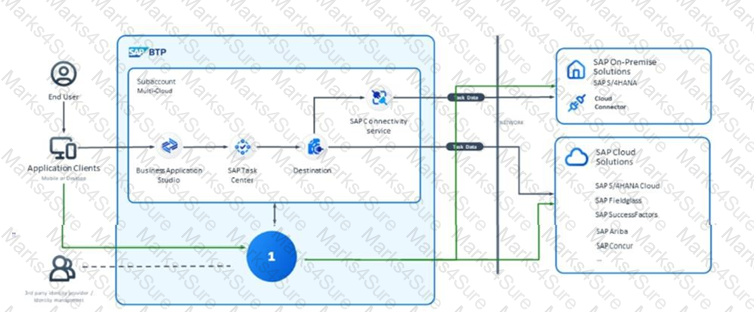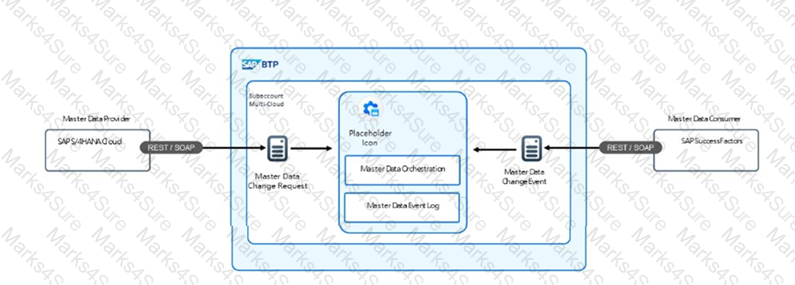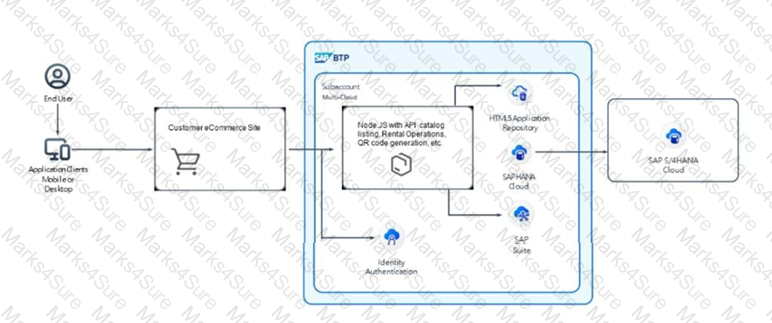You are a solution architect and your client has recently completed a merger and acquisition. Your client uses SAP S/4HANA Cloud Public Edition and the acquired company is using SAP ECC 6.0. For business and legal reasons, the users of the acquired company cannot yet be added to the global user directory. The acquired users still need access to the custom application.
Given the attached diagram, which solution would you recommend to your client in "1" to enable this access?

You are a solution architect assigned to a customer business transformation project.
Which solutions would you recommend the customers adopt to analyze and to optimize their procurement process to exceed industry benchmarks? Note: There are 2 correct answers to this question.
The customer is looking to use an SAP BTP service to replicate master data objects across connected business applications. The service should be based off of the process integration style and the integration use case pattern as defined in the SAP Integration Solution Advisory Methodology.
The customer wants to use an SAP BTP service to synchronize the workforce person master data object between SAP S/4HANA Cloud and SAP SuccessFactors HXM Suite as part of the Hire to Retire process (for cloud deployment). They prefer a service that uses a "hub and spoke" model to enable the synchronization.
Which of the following SAP solution should the customer use as the "Placeholder Icon" (see attached diagram)?

The DevOps / Site Reliability Team has a question for you. Over the course of the last month, several trust certificates have expired for several SAP BTP destinations, which has in turn occupied a significant portion of their time reinstalling. They wish to be informed before the certificate expires and to have a workflow triggered automatically.
As a solution architect, which SAP BTP service would you recommend (see attached diagram >)?

A manufacturer wants to discuss the design of a solution that tracks and manages stock availability and movement of goods within a warehouse. They want to ensure that movements are aggregated for reporting purposes and that these reports can be used to optimize stock movements. They also want to use the newest solutions to build these reports.
Which of the following solutions can be used together to fulfill the requirements? Note: There are 3 correct answers to this question.
According to the attached diagram, which SAP Integration Suite capability can a customer use to monetize their APIs? Note: There are 2 correct answers to this question.

Applications on a customer's Marketing subaccount continuously crash due to insufficient memory.
At the global account level, what can you use to allocate more memory to the Marketing subaccount?
A customer is asking you to provide a pricing plan given the following parameters:
•Payment annual in advance
•Purchase of additional capacity such as memory or storage without penalty
•Use of additional SAP BTP services without penalty Which pricing plan would you recommend?
A fit-to-standard analysis determined that the provided SAP Fiori App for SAP S/4HANA Cloud private edition was insufficient based on existing business requirements, and that a new front-end app must be built.
As a solution architect, you are asked to propose a solution and are told the following:
•The backend logic running on SAP S/4HANA Cloud private edition is sufficient and an appropriate remote API for create, read, update, and delete (CRUD) operations exists.
•The front-end app must be able to run on a variety of devices such as mobile phones and tablets.
•Front-end app instances must scale up or down automatically based on administrator- provided scaling parameters.
Which of the following runtimes would be optimal for the new front-end app? Note: There are 2 correct answers to this question.